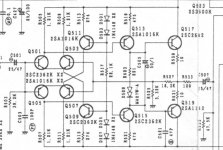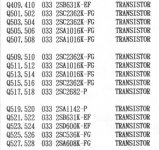Hi ! sorry for being the guy with the weird questions ... but there is this KISS principle always buzzing in my brain.
Is Overengineering a widespread practice in audio designs ? 😱
Just to talk about one case ... i am attaching the schematic of the gain stage of a line preamp
Why not to limit the circuit to the first push pull on the left maybe replacing the Q511-Q509 pair with the Q517-QQ519 pair and move the ouput stage to the left and in this way save 4 bjts ?
I am sure it could provide very similar electric performance in terms of distortion. Maybe the circuit would have lower PSRR ?
Would not be elegant a simpler schematic providing very similar (if not even better) performance (with the right selection of parts of course)
Let's remember we are talking about a line stage ... very small voltage gain needed and good driving ability (and with coupling cap at the output)
Thank you very much indeed.
Kind regards, gino
Is Overengineering a widespread practice in audio designs ? 😱
Just to talk about one case ... i am attaching the schematic of the gain stage of a line preamp
Why not to limit the circuit to the first push pull on the left maybe replacing the Q511-Q509 pair with the Q517-QQ519 pair and move the ouput stage to the left and in this way save 4 bjts ?
I am sure it could provide very similar electric performance in terms of distortion. Maybe the circuit would have lower PSRR ?
Would not be elegant a simpler schematic providing very similar (if not even better) performance (with the right selection of parts of course)
Let's remember we are talking about a line stage ... very small voltage gain needed and good driving ability (and with coupling cap at the output)
Thank you very much indeed.
Kind regards, gino
Attachments
Last edited:
q511, 507 are current sources which lower the distortion and gives higher gain for the input stage improving also the GNFB action.It's not wise to replace them with voltage sources...then q513, 515 can't deliver enough power because they need to run at lower currents to have high enough impedance for being able to read q501, 505 collector currents. Actually it would have been better to have two more transistors to adapt the impedance between q501 and 513 or to have a Lender type vas done with q513 , 515....they used very good transistors for the job anyway. Rotel doesn't really equate with overengineering, actually choosing 2sa1016 spared them a cascode if not two including the VAS...
Last edited:
Why not to limit the circuit to the first push pull on the left maybe replacing the Q511-Q509 pair with the Q517-QQ519 pair and move the ouput stage to the left and in this way save 4 bjts ?
Depends. Your shown example is not overengineered anyhow. If you're proposing connecting the output bjt's 517-519 directly to 501-505, massive distortion will result, so that's very typical underengineering. Do you have a degree in electronics?
q511, 507 are current sources which lower the distortion and gives higher gain for the input stage improving also the GNFB action.then q513, 515 can't deliver enough power because they need to run at lower currents to have high enough impedance for being able to read q501, 505 currents.Actually it would have been better to have two more transistors to adapt the impedance between q501 and 513 or to have a Lender type vas done with q513 , 515....they used very good transistors for the job anyway.Is this a Rotel?What amp is this?
Hi ! thanks a lot for the very kind and valuable reply. The schematic is from the Rotel RC-990bx preamp service manual available in the web for free, the line stage.
I am interested in this preamp having read great reviews. It should have performance almost on par with Rotel TOTL preamp (i.e. old Michi series)
If i understand well it is better to have a high gain stage and use more FB than to have a low gain stage and use less FB ? i am attaching the component list
You mean that for instance a Q501 cannot drive directly Q519 and needs a Q513 in between ?
A line stage has only to provide very little voltage gain and drive properly a power amp input stage ... nothing more.
Attachments
Last edited:
If they wouldn't have used the best transistor pair on the market they would have needed to have cascodes in both input and VAS for similar frequency response and then an impedance adapter ...so they spared 6 transistors in total...That's not overengineering, that's very smart engineering!Rotel doesn't really equate with overengineering, actually choosing 2sa1016 spared them a cascode if not two including the VAS...
That's a discrete op-amp with a gain of approx 7x...they probably needed that additional gain.A line stage has only to provide very little voltage gain and drive properly a power amp input stage ... nothing more.
Depends. Your shown example is not overengineered anyhow. If you're proposing connecting the output bjt's 517-519 directly to 501-505, massive distortion will result, so that's very typical underengineering.
Hi ! yes exactly that. To replace 513 with 519 and 515 with 517. You say that the distortion will increase massively ?
No of course. But i am fascinated by simple designs. Like the Sziklai pair, the diamond buffer, the Pass Aleph L ... some people pretend/insist they sound very good.Do you have a degree in electronics?
Attachments
Hi ! thanks a lot. So the design is very good indeed. Good to know. I am fascinated by a Zen approach to audio.If they wouldn't have used the best transistor pair on the market they would have needed to have cascodes in both input and VAS for similar frequency response and then an impedance adapter ...so they spared 6 transistors in total...That's not overengineering, that's very smart engineering!
That's a discrete op-amp with a gain of approx 7x...they probably needed that additional gain
sorry you mean the all gain block in the picture has gain x7 ?
What i meant was replacing Q513 with Q519 and Q515 with Q517, taking out the 513/515 pair.
I guess Q511 and Q509 have to stay instead ? what about using resistors instead ?
I am not able to calculate the open loop gain of this stage. I wonder if there is an optimum for the FB value in general. In line stages, the main object of my interest, i see opamp with very high open loop gain and high FB or design even with zero FB. They are all right or some are more right than others ?
My belief was that FB takes care of most of distortion lowering it. Clearly i was thinking wrong.
Last edited:
put it in lt spice and you'll have quickly all the calculations that you need, but i wouldn't doubt a well known product from rotel...it was one of their flagship models i think...
put it in lt spice and you'll have quickly all the calculations that you need, but i wouldn't doubt a well known product from rotel...it was one of their flagship models i think...
Thanks for the valuable. In your experience how well the results from sim compare with actual bench measurements ? are they quite dependable ?
if you have the right transistor models they do...but you can try with lower quality transistors.If they work well, better transistors will work too.Usually good designs work with lower quality components as well.
if you have the right transistor models they do...but you can try with lower quality transistors. If they work well, better transistors will work too. Usually good designs work with lower quality components as well.
Thank you very much indeed. No more weird questions.
Kind regards, gino
To distinguish engineering from over-engineering you need a design goal at first, a technical specification. Looking here in this forum you will find quite different opinions mostly based on listening tests and anecdotes. Without a general consensus about the technical limit what makes a good amp - everything is possible. And so you will find here people rolling capacitors, resistors, op-amps, mains cable debating in circles about their "huge sound improvements".
Thank you very much for your very helpful advice. My obsession are line stages. In particular solid state ones. I remember a review of a mid price Rotel pair ... the sound from the pair was fine ... but not exciting. Then they swapped the Rotel preamp for another brand tube one and bam ... they were shocked by the differences in all parameters ... dynamics, soundstage, midrange ... how can this be ? what was wrong with the Rotel pre ? what was right with the tube one ? mystery ...
Last edited by a moderator:
tubes are tubes...silicon will never sound like tubes and that just all about it.you better build yourself both versions and use them when ever you like...
Right. But you cannot get good bass from tubes ... impossible. That is a big problem. Tubes midrange is beautiful that is true.
bucks bunny said:Looking here in this forum you will find quite different opinions mostly based on listening tests and anecdotes.
Which is a pity. Forums like stackexchange.com DO NOT tolerate NON-TECHNICAL opinionated posts. They even go the extent of closing questions which they deem provoke suck replies.
Last edited:
That's a discrete op-amp ...
Thanks ! i will look for info about this topic. I guess there must be a wide selection of designs to choose from. If only i knew what to look for in terms of performance ... i know distortion, PSRR, ... what else to look for ?
- Home
- Member Areas
- The Lounge
- Overengineering in audio equipment

